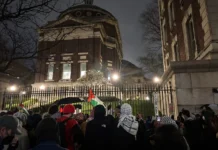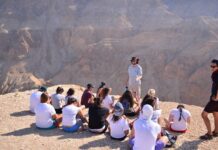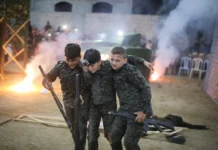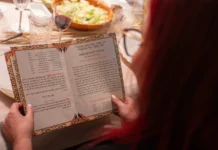Ask any Hebrew school child what the food bokser is, and you’ll receive a description of what sounds like tree bark. But you’ll also see that the student understands that this nearly inedible annual treat comes from Israel and is therefore to be treasured.
The appropriate blessings will be said and songs will be sung as this and other species from Israel are eaten on the holiday of Tu B’Shevat, the Jewish new year for trees.
Jews and the Land of Israel have been bound together from the time the Jewish people became a people. In fact, many of the 613 commandments can only be carried out within Israel. Moreover, extra holy days have been mandated for those living outside of the Jewish homeland in recognition of the fact that it requires extra effort and additional ritual observance to achieve the spiritual heights those living in Israel can achieve organically.
The Jewish story in the Land of Israel begins in Judea and Samaria, which are replete with Jewish history. Together with Jerusalem, they form the heartland of the country, the wellspring and foundation of Jewish history, where the holiest Jewish sites are found.
Hebron, in Judea, is mentioned 78 times in the Torah. It was here that Abraham purchased the Cave of Machpelah to bury his wife, Sarah. The site was the burial place of all of the patriarchs and matriarchs except for Rachel, who is buried in Bethlehem. Hebron was King David’s first capital.
Jerusalem is situated between Samaria and Judea. King David established it as his capital after ruling for over seven years from Hebron.
It is quite revealing that those who try to obscure and erase Jewish history exert the most pressure on Jews to leave these lands. Many today use the same tactics that were used by ancient conquerors and oppressors.
Visit the Arch of Titus in Rome and you will see images of the ancient Roman looters carrying off the treasures of the Temple. Similarly, holy places in Israel today are repeatedly vandalized.
In particular, the Temple Mount in Jerusalem has been recklessly bulldozed. Invaluable antiquities have been callously dumped in the Kidron Valley. Eventually, the Temple Mount Sifting Project was established to salvage these treasured remnants of Jewish history.
Joseph’s Tomb in Shechem has been subjected to unceasing acts of vandalism, desecration and arson. Jews trying to visit and pray at this sacred place are repeatedly met with violence.
A second tactic of the ancient Romans was to change the names of places, an effective scheme for hiding the history associated with a location. This stratagem has been implemented by Israel’s detractors today. Judea and Samaria are regularly referred to as the “West Bank,” a vapid dismissal of the sanctity and centrality of this fountainhead of Jewish history, Jewish faith and Jewish identity.
So successful has been this campaign against Jewish history that we see world leaders, politicians, journalists, teachers and others, whether through duplicity or ignorance, repeatedly misname this sacred ground.
The fact that the United Nations General Assembly recently passed a resolution asking the International Court of Justice to comment on the “occupation” of these areas indicates how destructive this subterfuge has been.
Given that the Land of Israel was never the sovereign country of any nation but the Jewish nation, Jews cannot be deemed “occupiers” there. Furthermore, the Jewish right to the Land of Israel has been a foundational principle and obligation of the U.N. since the body came into being.
In April of 1920, the Principal Allied Powers, who were invested with the authority to supervise the breakup of the former Ottoman Empire in the aftermath of World War I, met in San Remo, Italy.
For the Jewish homeland, they recognized the land between the Mediterranean Sea and the Jordan River, including what currently comprises Jordan, the Golan Heights and Gaza. They specified these particular regions because they are where Jews have lived since ancient times. The move to restore the Jewish people to their native land was then ratified by a unanimous vote of the League of Nations, correcting the historical injustice of forced exile.
The U.N. in turn assumed the obligations of the League of Nations according to Article 80 of the U.N. Charter. As such, the protection of the Jewish right to the historical Jewish homeland of Israel became a foundational principle and obligation of the U.N.
Thus, from the time of San Remo, Jewish rights to the Land of Israel have been unequivocally codified in international law. Using the term “occupation,” as the General Assembly resolution does, is a violation of the U.N.’s own legal obligations. As the guarantor of Jewish rights to the Land of Israel, the U.N. should be leading the way in speaking out when these rights are threatened.
Od yishama b’arei yehudah uvechutzot yerushalayim. “In the cities of Judah and the streets of Jerusalem, the sound of joy will again be heard.” We sing these words at a Jewish wedding when we remember Jerusalem and the cities of Judea. We call these places by their proper, legal names in song, so why not in every setting and conversation?
This year, in honor of Tu B’Shevat, let us reclaim that language for everyday use. Let us not allow this ancient ploy of renaming places to obscure history, memory and identity to prevail.
The religion, history, faith, culture and identity of the Jewish people came forth from these places. The mountains and hills of Samaria and Judea are our roots and our namesake. They are the fountainhead of Jewish civilization.
The fight for language is the fight for history.
It is one and the same.
Yonina Pritzker served as the spiritual leader of Boston-area congregations for over two decades. With an emphasis on Israel education, she has worked at The David Project developing curricula related to Israel, was a research analyst at CAMERA (Committee for Accuracy in Middle East Reporting in America) and was a co-founder of Rabbis and Ministers for Israel.


























